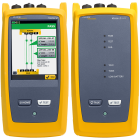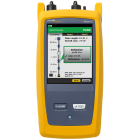Pérdida de inserción frente a pérdida de retorno
14 de agosto de 2024 / General, aprendizaje 101, instalación y comprobación
La pérdida de inserción y la pérdida de retorno son dos de los parámetros de rendimiento más críticos para los enlaces de cable de fibra óptica y de cobre de par trenzado. Representan aspectos independientes de la transmisión de señal y son diferentes para ambos tipos de medios. Aquí le explicaremos las diferencias clave entre estos dos parámetros, por qué son importantes y cómo interpretarlos.

¿Cuál es la diferencia entre pérdida de inserción y pérdida de retorno?
La pérdida de inserción es la energía que la señal pierde a medida que se transmite por un enlace de cableado. Es un fenómeno natural que se produce con todo tipo de señales, ya sean ópticas o eléctricas. Esta pérdida de señal, también llamada “atenuación”, aumenta con la longitud. Los puntos de conexión a lo largo del enlace de cableado (incluidos los conectores, splitters y empalmes) también causan pérdida de inserción. La pérdida de inserción se mide en decibelios (dB) y se expresa como número positivo.
- • En sistemas de cable de fibra óptica, la pérdida de inserción excesiva puede deberse al uso de componentes de calidad inferior o a una instalación inadecuada, por ejemplo, terminaciones de fibra contaminadas, mala alineación de los conectores o un radio de curvatura de fibra excesivo.
- • En los sistemas de cableado de cobre, la pérdida de inserción aumenta con la frecuencia y depende en gran medida del tamaño del conductor. Cuanto más grande es el calibre del conductor, menor es la pérdida de inserción. Las temperaturas más altas también pueden aumentar la pérdida de inserción en sistemas de cableado de cobre, lo que se convierte en una inquietud mayor en paquetes de cables de más de 60 W de potencia sobre ethernet (PoE). Obtenga más información sobre la pérdida de inserción y sus causas.
En contraste, la pérdida de retorno está relacionada con la cantidad de señal que se refleja de vuelta a la fuente de transmisión. Se mide al comparar la potencia de la señal de entrada con la cantidad reflejada. Al igual que la pérdida de inserción, la pérdida de retorno se mide en decibelios y se expresa como número positivo. Sin embargo, a diferencia de la pérdida de inserción, los valores de pérdida de retorno más altos son mejores: si no se reflejara la señal, habría una pérdida de retorno infinita.
- • En los sistemas de cableado de fibra, la pérdida de retorno es causada principalmente por reflejos en los puntos de conexión. Es por eso que los fabricantes de conectores especifican la pérdida de retorno de sus conectores de fibra específicos. El uso de terminaciones de conectores contaminadas, los espacios y las malas alineaciones también pueden causar reflejos en la señal. Las impurezas en la fibra introducidas durante la fabricación, así como las grietas, los extremos abiertos y un radio excesivo de curvatura de la fibra pueden empeorar la pérdida de retorno.
- • Al igual que la pérdida de inserción, la pérdida de retorno empeora con las frecuencias más altas en los enlaces de cableado de cobre. Es causada por desajustes de la impedancia entre los componentes o variaciones menores de la impedancia a lo largo de un cable. Para lograr una mejor pérdida de retorno, los fabricantes de cables de cobre y conectividad diseñan los enchufes y los conectores con impedancias que coinciden, y también controlan la uniformidad en todo el proceso de fabricación de los cables. La pérdida de retorno en los sistemas de cableado de cobre también puede deberse a que haya cables retorcidos o dañados, o a malas prácticas de terminación, por ejemplo, el destrenzado adicional innecesario de un par en los puntos de terminación. Obtenga más información sobre la pérdida de retorno y sus causas.
¿Por qué son importantes la pérdida de inserción y la pérdida de retorno?
La pérdida de inserción y la pérdida de retorno son indicadores clave del estado del sistema de cableado.
- • Si la pérdida de inserción es demasiado alta, la señal que transmite puede no tener suficiente potencia en el otro extremo del enlace para que el equipo activo la interprete de forma adecuada. Esto puede degradar el rendimiento o hacer que el enlace no funcione. Por eso, las normas del sector especifican límites de pérdida de inserción para aplicaciones de fibra específicas y categorías de cableado de cobre.
- • La pérdida de retorno es un parámetro esencial porque las señales reflejadas pueden interferir con las señales que se transmiten. Una pérdida de retorno deficiente también es sinónimo de menos potencia disponible en el otro extremo del cable, lo que puede causar pérdida de inserción. En otras palabras, un valor de pérdida de retorno más alto generalmente se correlaciona con un valor de pérdida de inserción más bajo. En los sistemas de cableado de cobre, la pérdida de retorno es esencialmente una medición de ruido. Una pérdida de retorno deficiente en los sistemas de cobre aumenta la diafonía, distorsiona las señales y causa índices de error de bits.
Cómo interpretar la pérdida de inserción
La pérdida de inserción es el principal parámetro que se mide al realizar comprobaciones de certificación de nivel 1 para sistemas de fibra, tal como lo describen las normas de cableado TIA e ISO, y como lo exigen los fabricantes de cableado y conectividad para recibir una garantía del sistema. La pérdida de inserción se mide en un enlace mediante un juego de comprobación de pérdida óptica (OLTS) como el CertiFiber® Pro de Fluke Networks. El OLTS emite una fuente de luz en un extremo del enlace y usa un medidor de potencia en el otro extremo para medir la señal recibida y compararla con la cantidad emitida. Si la pérdida de inserción falla la comprobación de certificación con un OLTS, un reflectómetro de dominio de tiempo óptico (OTDR) como el OptiFiber® Pro OTDR de Fluke Networks puede medir la pérdida de eventos específicos, como rupturas, curvaturas, empalmes y conectores. Esto puede ayudar a determinar la causa y la ubicación exacta del evento de pérdida. Obtenga más información sobre la relación entre un OLTS y un OTDR.
El principal procedimiento de comprobación de pérdida de inserción en los sistemas de fibra es el método de referencia de un puente. Esto incluye la pérdida del primer y el último conector, lo que representa cómo se usará la instalación del cableado en última instancia. En sistemas de fibra multimodo, la comprobación de la pérdida de inserción requiere condiciones de lanzamiento de flujo restringido (Encircled Flux, EF), que controla cómo se lanza la luz a la fibra para evitar un lanzamiento demasiado lleno, que podría causar resultados pesimistas, o un lanzamiento bajo el nivel de llenado, que podría conducir a resultados optimistas.
La pérdida de inserción también es un parámetro de rendimiento clave que se requiere para la comprobación de certificación de cobre y la adquisición de una garantía del fabricante. Se comprueba por medio de un certificador de cobre, como la serie DSX CableAnalyzer™ de Fluke Networks, que comprueba la pérdida de inserción en un intervalo de frecuencia completo de cada par para el tipo específico de cableado de cobre. Por ejemplo, en un sistema de categoría 6, la pérdida de inserción se comprueba de 1 a 250 MHz, mientras que un sistema de categoría 6A se prueba de 1 a 500 MHz.
Obtenga más información sobre la comprobación de pérdida de inserción en sistemas de cableado de fibra y cobre.
Cómo interpretar la pérdida de retorno
En los sistemas de fibra, la pérdida de retorno se mide en un enlace por medio de un OTDR, como el OptiFiber Pro. El OTDR transmite pulsos de luz de alta potencia a la fibra. Cuando estos pulsos se encuentran con eventos reflexivos (es decir, conexiones, rupturas, grietas, empalmes, curvaturas pronunciadas o el final de la fibra), se reflejan y se miden. El total de la luz reflejada de todos los eventos y la retrodispersión total del enlace tiene como resultado el valor de pérdida de retorno total del enlace. Tenga en cuenta que un OTDR también puede proporcionar valores de reflectancia y ubicación para cada evento individual. Sin embargo, la reflectancia es lo opuesto a la pérdida de retorno y es un número negativo. Obtenga más información en nuestro artículo sobre la diferencia entre pérdida de retorno y reflectancia.
La pérdida de retorno es un parámetro de rendimiento que se requiere para la comprobación de certificación de cobre y la adquisición de una garantía del fabricante. Al igual que la pérdida de inserción, se comprueba a lo largo de todo el rango de frecuencia para cada par mediante un certificador de cobre, como el DSX CableAnalyzer. La pérdida de retorno fallida en un solo punto de frecuencia suele ser indicio de que hay un inconveniente con el cable. Si los cuatro pares fallan (especialmente en frecuencias más bajas), puede ser indicio de que hay un cable de baja calidad o agua en el cable.
Obtenga más información sobre la comprobación de pérdida de retorno en sistemas de cableado de fibra y cobre.









